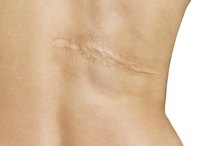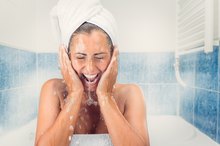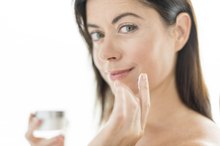Creams for the Removal of Milia
Milia is a skin condition in which dead skin remains trapped in a small pocket on the skin's surface, similar to tiny whiteheads. Milia can be classified as primary, fluid-filled cysts from skin cells that did not shed properly, or secondary, where cysts are a result of something clogging the skin ducts, such as an existing skin condition or injury. While milia is common in infants and usually does not need to be treated, in adults it lasts longer and may require treatment. There are various creams available that will remove primary milia and various ways in which to prevent its development.
Retinoid Cream
Retinoid cream, otherwise known as Vitamin A cream, is often prescribed by a doctor. This prescription cream tends to have exfoliating properties, causing the skin to dry and peel, unclogging pores and rejuvenating cells. Retinoid cream works more quickly than the over-the-counter version, retinol, because the active ingredient, retinoic acid, is already present. Examples of prescription-strength retinoid creams include adapalene, tazarotene or tretinoin. It is best to use this cream before bedtime as skin will be more sensitive to UV rays after use. Do not use this cream if you are pregnant or breastfeeding as Vitamin A can be harmful in excess 1.
- Retinoid cream, otherwise known as Vitamin A cream, is often prescribed by a doctor.
- This prescription cream tends to have exfoliating properties, causing the skin to dry and peel, unclogging pores and rejuvenating cells.
Retinol Cream
What Are the Benefits of Retinol Cream?
Learn More
Retinol cream acts to remove milia much like retinoid cream. While retinol cream has exfoliating properties and serves to increase cell production in the top layer of the skin, it is weaker than retinoid cream. This formula is available over-the-counter. Rather than containing the active ingredient, retinoic acid, it gradually converts into the active ingredient, a less potent Vitamin A compound. It may take more time before results are seen. Retinol cream is less irritating to the skin, and it is less expensive than retinoid crean. Retinol cream typically varies in the percentage of retinol it contains, up to one percent. Like retinoid cream, it should ideally be applied at bedtime.
- Retinol cream acts to remove milia much like retinoid cream.
- While retinol cream has exfoliating properties and serves to increase cell production in the top layer of the skin, it is weaker than retinoid cream.
Alpha Hydroxy Acid (AHA) Cream
Cream containing Alpha Hydroxy Acid (AHA) also removes milia by causing exfoliation. AHAs are natural acids that allow the top layer of dead skin to come off easily. Depending on the concentration of AHA in the cream, there may be more or less shedding of the skin. Glycolic acid is the most common AHA in skin care products, according to the Doctor Good Skin website 3. Other AHAs include fruit acids and lactic acid. Overall, AHA creams tend to improve the skin's general condition, texture and tone, while unblocking and cleansing pores. AHAs do increase susceptibility to sun damage, so always wear a sunscreen during use and for approximately one week after.
- Cream containing Alpha Hydroxy Acid (AHA) also removes milia by causing exfoliation.
- Overall, AHA creams tend to improve the skin's general condition, texture and tone, while unblocking and cleansing pores.
Preventing Milia
The Difference Between Retinol and Retin-A
Learn More
There are a number of things you can do to prevent the development of milia 1. Make sure to moisturize with an oil-free moisturizer as dead skin cells can result from flaking skin that lacks moisture. Avoid heavy skin care products and cosmetics 1. Try to choose high-quality and oil-free products. Avoid too much sun exposure as this can thicken the skin and make it harder to exfoliate. Most importantly, try to implement regular exfoliation in your skincare regime. Light regular exfoliation goes a long way toward preventing milia.
- There are a number of things you can do to prevent the development of milia 1.
- Most importantly, try to implement regular exfoliation in your skincare regime.
Related Articles
References
- Oprah.com: Your Skin's New Best Friend
- OneHealthyLifestyle.com: Milia
- DoctorGoodSkin.com: AHAs: How AHAs work?
- Yahya H. Idiopathic multiple eruptive milia: Report of a case in a Nigerian woman. Niger J Clin Pract. 2018;21(3):395-6. doi:10.4103/njcp.njcp_43_17
- Kutlubay Z, Tanakol A, Engýn B, et al. Newborn skin: common skin problems. Maedica (Buchar). 2017;12(1):42-7.
- Cho E, Cho SH, Lee JD. Idiopathic multiple eruptive milia occurred in unusual sites. Ann Dermatol. 2010;22(4):465-7. doi:10.5021/ad.2010.22.4.465
- Ghosh S, Sangal S. Congenital milia en plaque on scalp. Indian J Dermatol. 2015;60(1):105. doi:10.4103/0019-5154.147871
- Hinen HB, Gathings RM, Shuler M, Wine lee L. Successful treatment of facial milia in an infant with orofaciodigital syndrome type 1. Pediatr Dermatol. 2018;35(1):e88-e89. doi:10.1111/pde.13350
Writer Bio
Based in New Hamburg, Ontario, Mary Margaret Peralta has been writing for websites since 2010. She has developed a company website and a health and safety manual for a past employer. Peralta obtained her Bachelor of Arts in sociology from the University of Waterloo in Waterloo, Ontario.









